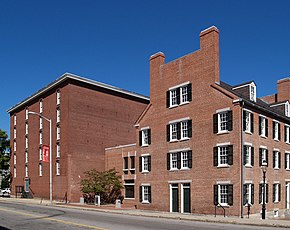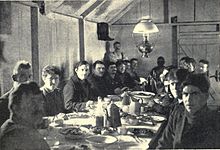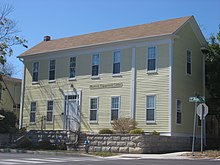Best Rooming Houses in Orange County New York

A boarding business firm is a house (often a family home) in which lodgers rent 1 or more rooms on a nightly basis, and sometimes for extended periods of weeks, months, and years. The mutual parts of the house are maintained, and some services, such every bit laundry and cleaning, may exist supplied. They ordinarily provide "room and board," that is, at least some meals as well every bit adaptation.
Lodgers legally simply obtain a licence to apply their rooms, and non exclusive possession, and then the landlord retains the right of admission.[1]
Arrangements [edit]

Early-20th-century dinner in a miners' boarding house in northern Canada
Formerly boarders would typically share washing, breakfast and dining facilities; in recent years it has become mutual for each room to take its own washing and toilet facilities. Such boarding houses were often institute in English language seaside towns (for tourists) and higher towns (for students). It was common for in that location to be one or two elderly long-term residents. "The phrase "boardinghouse achieve" [referring to a diner reaching far across a dining table] comes from an important variant of hotel life. In boardinghouses, tenants hire rooms and the proprietor provides family-fashion breakfasts and evening dinners in a common dining room. Traditionally, the food was put on the table, and everyone scrambled for the best dishes. Those with a long, fast reach ate best."[2]
Boarders can often arrange to stay bed-and-breakfast (bed and breakfast merely), half-board (bed, breakfast and dinner merely) or total-board (bed, breakfast, lunch and dinner). Peculiarly for families on holiday with children, boarding (particularly on a full-board basis) was an cheap alternative and certainly much cheaper than staying in all just the cheapest hotels.
History [edit]

Maroochydore Boarding Firm, Queensland, circa 1917
Boarding houses were common in near United states cities throughout the 19th century and until the 1950s.[three] In Boston in the 1830s, when the landlords and their boarders were added up, between one-third and 1-half of the city'due south entire population lived in a boarding house.[iii] Boarding houses ran from large, purpose-congenital buildings down to "genteel ladies" who rented a room or ii as a fashion of earning a picayune actress coin.[3] Large houses were converted to boarding houses as wealthy families moved to more fashionable neighborhoods.[iii] The boarders in the 19th century ran the gamut every bit well, from well-off businessmen to poor laborers, and from single people to families.[iii] In the 19th century, between 1/3 to 1/2 of urban dwellers rented a room to boarders or were boarders themselves.[four] In New York in 1869, the toll of living in a boarding house ranged from $2.50 to $40 a week.[iii] [a] Some boarding houses attracted people with particular occupations or preferences, such as vegetarian meals.[iii]
The boarding house reinforced some social changes: information technology made it feasible for people to move to a big city, and abroad from their families.[3] This distance from relatives brought social anxieties and complaints that the residents of boarding houses were not respectable.[3] Boarding out gave people the opportunity to run into other residents, so they promoted some social mixing.[3] This had advantages, such every bit learning new ideas and new people's stories, and also disadvantages, such every bit occasionally meeting disreputable or dangerous people. Nearly boarders were men, but women found that they had limited options: a co-ed boarding house might mean meeting objectionable men, simply an all-female person boarding house might be – or at least be suspected of being – a brothel.[iii]
Boarding houses attracted criticism: in "1916, Walter Krumwilde, a Protestant minister, saw the rooming house or boardinghouse arrangement [every bit] "spreading its spider web like a spider, stretching out its arms like an octopus to catch the unwary soul."[2] Attempts to reduce boarding firm availability had a gendered affect, as boarding houses were typically operated or managed by women "matrons"; closing boarding houses reduced this opportunity for women to brand a living from operating these houses.[6]
Later, groups such as the Young Women's Christian Association provided heavily supervised boarding houses for young women.[3] Boarding houses were viewed every bit "brick-and-mortar chastity belts" for young unmarried women, which protected them from the vices in the city.[4] The Jeanne d'Arc Residence in Chelsea, which was operated past an lodge of nuns, aimed to provide a dwelling infinite for young French seamstresses and nannies.[four] Married women who boarded with their families in boarding houses were accused of being likewise lazy to do all of the washing, cooking, and cleaning necessary to go on house or to raise children properly.[3] While there is an association between boarding houses and women renters, men also rented, notably the poet-authors Walt Whitman and Edgar Allan Poe.[4]
In the decades after the 1880s, urban reformers began working on modernizing cities; their efforts to create "uniformity inside areas, less mixture of social classes, maximum privacy for each family, much lower density for many activities, buildings set back from the street, and a permanently built order" all meant that housing for single people had to exist cut back or eliminated.[2] By the early 1930s, urban reformers were typically using codes and zoning to enforce "uniform and protected single-employ residential district[southward] of private houses", the reformers' preferred housing type.[2] In 1936, the FHA Holding Standards defined a abode as "any structure used principally for residential purposes", noting that "commercial rooming houses and tourist homes, sanitariums, tourist cabins, clubs, or fraternities would not be considered dwellings" as they did not have the "private kitchen and a private bath" that reformers viewed as essential in a "proper abode".[2] As a result, boarding houses became less common in the early on 20th century. Another gene that reduced boarding house numbers was that improved mass transit options fabricated it viable for more than city residents to alive in the suburbs and piece of work in the city.[3]
By the 1930s, boarding houses were becoming less mutual in virtually of the Usa.[three] In the 1930s and 1940s, "rooming or boarding houses had been taken for granted as respectable places for students, single workers, immigrants, and newlyweds to live when they left dwelling house or came to the city".[vii] Notwithstanding, with the housing boom in the 1950s, eye class newcomers could increasingly afford their own homes or apartments, which meant that rooming and boarding houses were beginning to be used more than often past post-secondary "students, the working poor, or the unemployed".[8] By the 1960s, rooming and boarding houses were deteriorating, every bit official city policies tended to ignore them.
Similar concepts [edit]

The common lodging-house or flophouse normally offered a space to slumber, just lilliputian else. When used for temporary purposes, this arrangement was like to a hostel. Flophouse beds may offer dormitory-style infinite for as footling as one night at a time.
A lodging house, also known in the U.s. equally a rooming house, may or may not offer meals.
Single room occupancy (SRO) buildings rent individual rooms to residents, and have a shared bathroom; some may have a shared kitchen space for residents to cook their own meals.[3]
Dormitory accommodations for post-secondary students are like to a boarding houses when they include cafeterias.[iii]
In the 2010s, microapartments with one or two rooms rented plus access to shared mutual spaces in the building are very similar to boarding houses.[three] WeWork, a company mostly known for its shared coworking rental spaces, is also offering shared housing arrangements in which renters get a individual sleeping room but share a kitchen, living room, and other common areas.
Bed and breakfast adaptation (B&B), which exists in many countries in the world (due east.1000. the UK, the United States, Canada, and Australia), is a specialized form of boarding firm in which the guests or boarders commonly stay only on a bed-and-breakfast footing, and where long-stay residence is rare.
However, some B&B adaptation is made bachelor on a long-term basis to UK local authorities who are legally obliged to house persons and families for whom they have no social housing available.[ description needed ] Some such boarding houses allow large groups with low incomes to share overcrowded rooms, or otherwise exploit people with problems rendering them vulnerable, such as those with irregular immigration status. Such a boarding-house may well cease to be bonny to brusque-term lodgers, and the residents may remain in unsatisfactory accommodation for long periods. Much old seaside accommodation is so used, since cheap flights have reduced need for their original seasonal holiday utilise.
Apart from the worldwide spread of the concept of the B&B, at that place are equivalents of the British boarding houses elsewhere in the world. For case, in Japan, minshuku are an almost exact equivalent although the normal organization would be the equivalent of the English half-board. In Hawaii, where the toll of living is loftier and incomes barely proceed pace,[ citation needed ] it is common to take in lodgers (who are boarders in English terminology) that share the burden of the overall hire or mortgage payable.
In the Indian subcontinent boarders are too known as paying guests. Paying guests stay in a habitation and share a room with domestic facilities. Rates are nominal and monthly charges are normally inclusive of food, bed, tabular array and a cupboard. The hire can go higher for a room in an upscale locality with facilities like unmarried occupancy, air conditioning and loftier-speed wireless internet access.
Legal restrictions [edit]
In the United States, zoning has been used by neighborhoods to limit boarding houses.
In popular civilisation [edit]
Literature [edit]
- In Little Women, Jo March moves to New York Urban center to pursue her literary career and lives in a boarding house where she meets a multifariousness of boarders. She develops a relationship with one of them, Professor Bhaer.
- Sherlock Holmes lived in a boarding house at 221B Baker Street, of which the landlady Mrs. Hudson provided some domestic service.
- Addy Walker is a character in the American Girl historical collection her story takes place in the mid 1860s, and the majority of the books in her series feature her and her family living in a boarding firm in Philadelphia.
- Mary Roberts Rinehart wrote the now-archetype boarding-business firm mystery, The Instance of Jennie Brice, in 1913.
- H. M. Wells satirized boarding houses of the Edwardian era in his novel The Dream (1924).
- E. Phillips Oppenheim fix his espionage novel, The Foreign Boarders of Palace Crescent (1934) in a London boarding house.
- The climax of Patrick Hamilton's 1941 novel Hangover Square occurs in a dirty Maidenhead boarding business firm.
- Lynne Reid Banks's 1960 novel The L-Shaped Room is set in a run-down boarding house.
- Ben Mears, the main graphic symbol in the 1975 horror novel Salem's Lot by Stephen King, stays at Eva Miller'south boarding firm.
- Harry Dresden, from the book serial The Dresden Files past Jim Butcher lives in the rented basement of a boarding house early in the series.
- In True Grit, the master protagonist, Mattie Ross, stays at the Monarch Boarding Firm where she is forced to share a bed with Grandma Turner, ane of the long-term residents and where a robust communal repast takes place.
- The young heroes in Horatio Alger'southward 19th-century rags-to-riches tales oftentimes feel life in boarding houses and single works oftentimes depict both unscrupulous and kindly boarding house proprietors as the characters make their way upward (or downward) in the globe.
Films [edit]
- The 1922 film, The Light in the Nighttime, has a boarding business firm as its setting.
- The 1927 film, The Lodger, has a boarding firm as its setting.
- The 1931 motion picture, Dr. Jekyll and Mr. Hyde, shows a boarding house.
- In the 1933 moving picture, Son of Kong, Carl Denham (Robert Armstrong) stays in a boarding firm.
- The 1937 film, Stage Door, has a boarding house for its setting.
- In the 1939 film, The Story of Alexander Graham Bell, Alexander Graham Bell (Don Ameche) stays in a boarding house.
- In the 1941 pic, Citizen Kane, Kane's parents ain a boarding house.
- In the 1942 motion-picture show, Yankee Doodle Dandy, George M. Cohan (James Cagney) stays in a boarding house.
- In the 1942 film, The Magnificent Ambersons, the original ending took place in a boarding house.
- The 1945 pic, The Adult female in Green, shows a boarding firm.
- In the 1946 flick, It'southward a Wonderful Life, the Baileys own a boarding house.
- The 1950 picture show, Riding High, briefly shows a boarding firm.
- In the 1950 film, Mystery Street, Mrs. Smerrling (Elsa Lanchester) owns a boarding house.
- Much of the plot in the 1951 film The Twenty-four hour period the World Stood Still, takes place in a Washington, DC boarding house.
- In the 1952 film, The Story of Volition Rogers, Will Rogers (Volition Rogers Jr.) stays in a boarding house.
- In the 1957 film, The Buster Keaton Story, The Keatons stay in a boarding house.
- In The Shootist (1976), J. B. Books (John Wayne) rents a room at a Carson City, Nevada boarding house. Dying of cancer, Books wishes to finish his days in peace and repose. But old enemies with scores to settle converge.
- In the 1982 film Liar's Moon, Jack Duncan and Ginny Peterson run away from their parents in Texas to marry each other and stay in a boarding house in Louisiana.
- The film Tales from the Crypt: Demon Knight, takes place in a boarding house. It was one time a church until it was turned into a boarding house. Brayker and the residents boxing the demons in this boarding firm.
- Sandy Brooks and Nick Snowden the main characters in Snowfall lived in a boarding house.
- In Brooklyn, the master protagonist, Eilis Lacey, stays at a boarding business firm.
Television [edit]
- A pair of puppet shows released on home video characteristic an older adult female chosen Bubbie who runs a boarding business firm. Bubbie hosts her grandchildren and their friend for Hanukkah and Passover celebrations with her boarders; she takes a piffling fourth dimension to explain to the young man delivering the Hanukkah groceries how a boarding firm works.
- Mr Bean lives in a boarding house in the early on episodes.
- Mary Richards, the main grapheme in The Mary Tyler Moore Prove, lives in a studio flat in a Victorian boarding house.
- In the drawing Groovie Goolies, the characters of that show reside at a boarding house called Horrible Hall that is located on Horrible Drive.
- In the 1981 CBS made-for-television horror motion picture, Dark Night of the Scarecrow, the boondocks'south postman, Otis P. Hazelrigg, lives in Mrs. Agglomeration's boarding business firm.
- The titular protagonist of the Nickelodeon television show Hey Arnold! lives in a boarding house (chosen "Sunset Arms") that's endemic and operated by his paternal grandparents, Phillip "Phil" and Gertrude "Gertie" Shortman.
- In The Vampire Diaries, Stefan and Damon Salvatore live in the old Salvatore Boarding house when they render to Mystic Falls.
- In The Andy Griffith Show, Barney Fife is a long-term resident of a boarding firm run by Mrs. Mendelbright. When she catches Barney cooking in his room with a hot plate, she asks him to leave.
- The South Korean television series Reply 1994 is set in a nineties boarding house.
- In the Torchwood episode "Immortal Sins", Jack Harkness, and his companion Angelo Colasanto stay in a boarding house.
Comics [edit]
- Many of the scenes in the comic strip Flower County took identify at the Bloom Boarding house endemic by the family of main graphic symbol Milo Bloom.
- Our Boarding House (1921–1984) was an American single-panel cartoon and comic strip set in a boarding firm run past the sensible Mrs. Hoople.
Lath games [edit]
- In Fantasy Flight Games' board game Arkham Horror numerous encounters occur at Ma's Boarding firm.
Meet also [edit]
- Boarding schoolhouse
- List of human being habitation forms
- Room and board
- Hostel
- House in multiple occupation
- Rooming business firm
- Single room occupancy
-
 Housing portal
Housing portal
Notes [edit]
- ^ For comparison purposes, a laborer in the construction trades in New York usually earned $ane.00 to $1.50 per day effectually that fourth dimension.[v]
References [edit]
- ^ Chisholm, Hugh, ed. (1911). . Encyclopædia Britannica. Vol. 4 (11th ed.). Cambridge University Press. p. 95.
- ^ a b c d east Groth, Paul. Living Downtown: The History of Residential Hotels in the United States. Chapter One – Conflicting Ideas about Hotel Life. Berkeley: University of California Press, 1994. http://ark.cdlib.org/ark:/13030/ft6j49p0wf/
- ^ a b c d e f one thousand h i j 1000 l chiliad due north o p q r Graham, Ruth (13 Jan 2013). "Boardinghouses: Where the Urban center was Born". The Boston Globe . Retrieved 2018-04-20 .
- ^ a b c d Hester, Jessica Leigh (22 February 2016). "A Brief History of Co-Living Spaces". world wide web.citylab.com. City Lab. Retrieved 10 November 2018.
- ^ Wholesale prices, wages, and transportation. Written report past Mr. Aldrich, from the Commission on Finance, March 3, 1893. Washington. 1893. p. 449. hdl:2027/uc1.c061422449.
- ^ Groth, Paul. Living Downtown: The History of Residential Hotels in the United States. Affiliate Eight – From Scattered Opinion to Centralized Policy. Berkeley: Academy of California Press, 1994. http://ark.cdlib.org/ark:/13030/ft6j49p0wf/
- ^ Campsie, Philippa (1994). "A Brief History of Rooming Houses in Toronto, 1972–94" (PDF). world wide web.urbancenter.utoronto.ca. Rupert Community Residential Services. Retrieved 10 November 2018.
- ^ Campsie, Philippa (1994). "A Brief History of Rooming Houses in Toronto, 1972–94" (PDF). www.urbancenter.utoronto.ca. Rupert Customs Residential Services. Retrieved 10 November 2018.
cawkerfacquirling.blogspot.com
Source: https://en.wikipedia.org/wiki/Boarding_house
0 Response to "Best Rooming Houses in Orange County New York"
Post a Comment